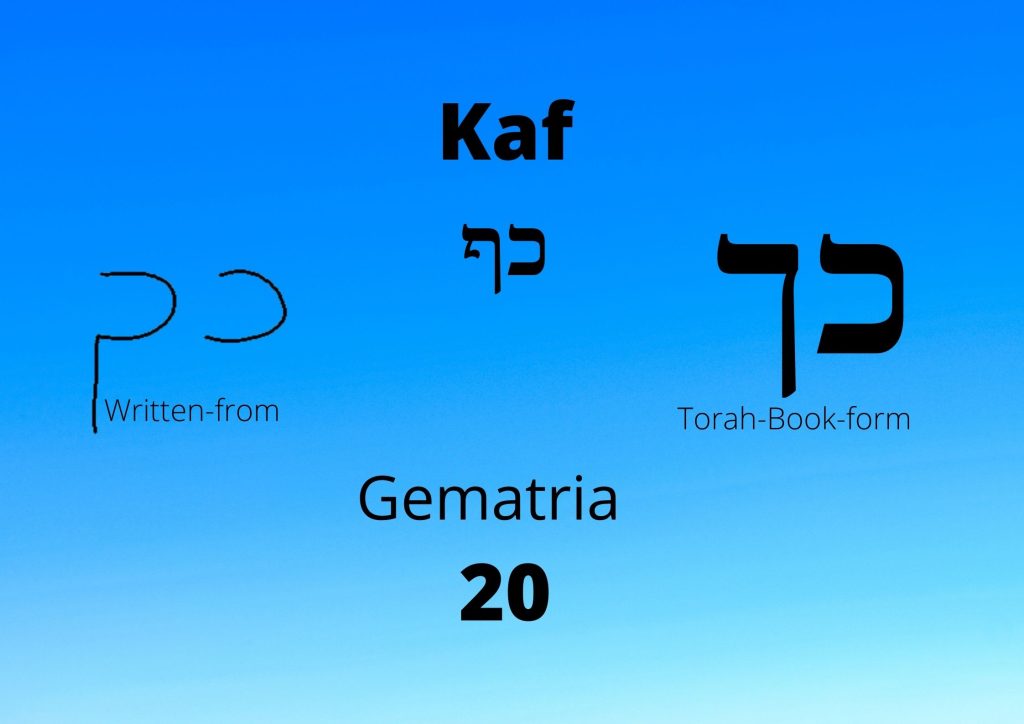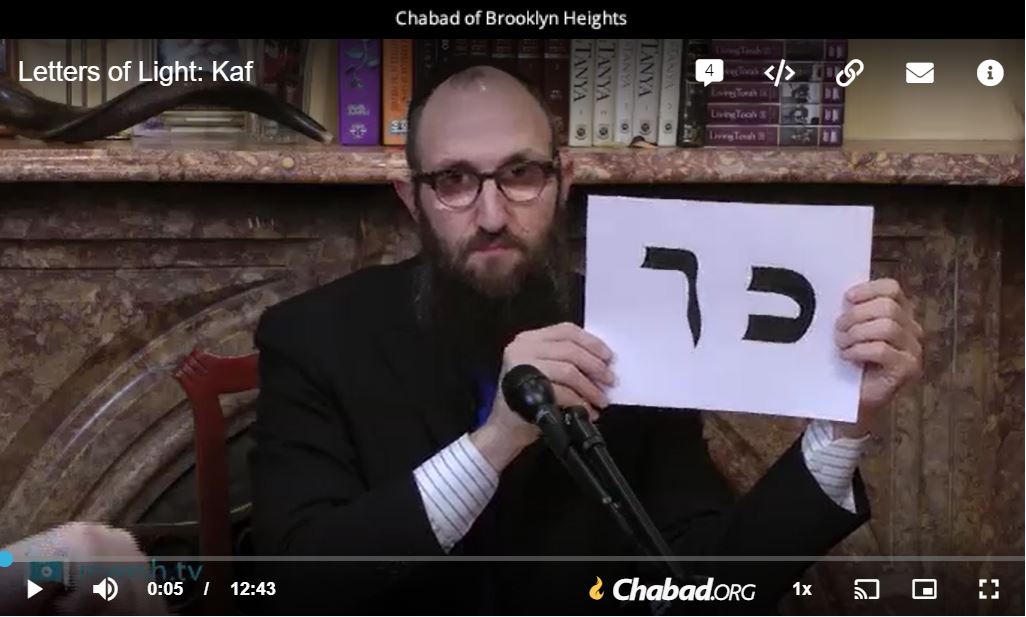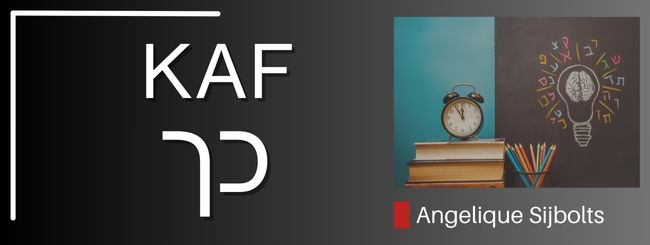
In this blog, we are going to look at the letter kaf כ
The kaf has the sound “k” as in “king”, and as “ch” as in “Bach”. The difference in pronunciation is visible by a dot in the kaf, which represents the hard “k” כּ sound. This letter has a different shape at the end of a word ך
The gematria is 20
With 10 utterances, G-d created the world, a world in which He desires to dwell, a creation with which He wishes to have a relationship. In His Omniscience, G-d knew that the Jewish people would accept and undertake His 10 commandments at Sinai, which made Him aware that although the early generations of humanity might forget Him and not wish to live in accordance with His will, there would arise a people who would accept Him as King and observe His 613 commandments. These 10 utterances and commandments bring us to the number 20, the numerical value of the letter “kaf”.
The kaf כ has a closed form; if there are no people who accept G-d’s kingship, He is King, but – so to speak – King in heaven. The moment there are people who accept His Kingship, His Kingship is – as it were – drawn down to earth ך. We also see that the word king, מלך “melech,” ends with a final kaf.
When people accept His Kingship, they will strive to study His commandments as best as possible, bending their own wills to do His will, which brings Him joy. This is also known as the “crown of the Torah.”
We see that the gematria of “keter” is 620, which is precisely the number of letters needed for the Aseret Hadibrot, the Ten Commandments, corresponding to the 613 commandments plus the seven days of creation, seven Noahide Laws, or the seven rabbinic commandments. And it is the numerical value of the word עשרים “twenty,” which is the numerical value of the word “kaf.”[1]
It is good for people to bend [one of the meanings of “kaf”] their wills and strive to observe the commandments as best they can, thereby strengthening and enlarging their relationship with G-d and with their fellow humans. However, we all know people who can be so fanatical about this that it damages relationships.
We must take heed of Pirkei Avot, Chapter 4, Mishna 13, which writes in the name of Rabbi Shimon about the different crowns. Rabbi Shimon writes, among other things, about the crown of the Torah and the crown of a good name. The latter is the most important of all the crowns he discusses. We must have a good name in our surroundings, we must stand out positively so that people become curious about our lifestyle and want to know more about G-d and His Torah.
But we all make mistakes in our relationships with our fellow humans and in our relationship with G-d. Mistakes for which we want to show repentance; it is the kaf in its bent form that reminds us of the shofar… that calls us to repentance… knowing that G-d will always accept sincere repentance and help us straighten out everything that is bent in our lives.
When we show repentance or when we perform a commandment because He asks us to, we place ourselves, as it were, in His hand, in His hand of life, thereby participating in the world to come. The Torah then becomes a potion of life, סס חיים, and for those who do not wish to fulfill their purpose of creation, it is a potion of death, ומות, which together also has the numerical value of 620.
What we can learn from the letter kaf
1. The symbolic significance of the Hebrew letter “kaf” in Jewish thought, representing humility, acceptance of God’s sovereignty, and willingness to fulfill His commandments.
2. The importance of accepting G-d’s kingship and willingly following His commandments as a means of strengthening one’s relationship with Him.
3. The connection between the Ten Commandments, the 613 mitzvot, and the creation of the world, illustrating the unity and purpose behind God’s plan for humanity.
4. The concept of “keter” (crown) in Jewish mysticism, symbolizing the Torah’s significance and the commitment to study and integrate its teachings into one’s life.
5. The need to maintain a balance between religious observance and interpersonal relationships to avoid extremism that may strain human connections.
6. Insights drawn from Pirkei Avot, specifically chapter 14, mishna 13, which discusses various “crowns” in Jewish tradition, emphasizing the value of a good reputation among people.
7. Embracing the concept of repentance (teshuvah) as a means of rectifying mistakes and returning to a path aligned with G-d’s will, symbolized by the bowed form of the letter “kaf.”
8. Understanding the dichotomy presented in Torah teachings regarding life and death, where adherence to G-d’s purpose leads to life (חיים), while neglecting one’s purpose results in death (מות).
9. The significance of integrating Torah teachings into daily life, leading to spiritual fulfillment and participation in the future world.
10. Recognizing that the journey of spiritual growth involves ongoing learning, reflection, and commitment to living in accordance with G-d’s will.
We are now familiar with the:
ט ח ו ב י ת א ל פ ף ג מ ם ד ה ז כ ך
ֹand can now read the following words, among others:
Proverbs 31:20
20She spreads out her hand to the poor man, and she stretches her hands out to the needy. | ככַּפָּהּ פָּרְשָֹ֣ה לֶעָנִ֑י וְ֜יָדֶ֗יהָ שִׁלְּחָ֥ה לָֽאֶבְיֽוֹן: |
Exodus 1:15
15Now the king of Egypt spoke to the Hebrew midwives, one who was named Shifrah, and the second, who was named Puah. | טווַיֹּ֨אמֶר֙ מֶ֣לֶךְ מִצְרַ֔יִם לַֽמְיַלְּדֹ֖ת הָֽעִבְרִיֹּ֑ת אֲשֶׁ֨ר שֵׁ֤ם הָֽאַחַת֙ שִׁפְרָ֔ה וְשֵׁ֥ם הַשֵּׁנִ֖ית פּוּעָֽה: |
Genesis 2:1
| 1Now the heavens and the earth were completed and all their host. | אוַיְכֻלּ֛וּ הַשָּׁמַ֥יִם וְהָאָ֖רֶץ וְכָל־צְבָאָֽם: |
To hear the texts, see youtube below


By Angelique Sijbolts
Sources:
Understanding the Symbolism of the Letter Kaf and Its Significance in Jewish Thought
With 10 utterances, God created the world, a world in which He desires to dwell, a creation with which He wishes to have a relationship. In His Omniscience, God knew that the Jewish people would accept and undertake His 10 commandments at Sinai, which made Him aware that although the early generations of humanity might forget Him and not wish to live in accordance with His will, there would arise a people who would accept Him as King and observe His 613 commandments. These 10 utterances and commandments bring us to the number 20, the numerical value of the letter “kaf”.
The kaf has a closed form; if there are no people who accept God’s kingship, He is king, but – so to speak – king in heaven. The moment there are people who accept His kingship, His kingship is – as it were – drawn down to earth. We also see that the word king, “melech,” ends with a final kaf.
When people accept His Kingship, they will strive to study His commandments as best as possible, bending their own wills to do His will, which brings Him joy. This is also known as the “crown of the Torah.”
We see that the gematria of “keter” is 620, which is precisely the number of letters needed for the Aseret Hadibrot, the Ten Commandments, corresponding to the 613 commandments plus the seven days of creation, seven Noahide Laws, or the seven rabbinic commandments. And it is the numerical value of the word “twenty,” which is the numerical value of the word “kaf.”[1]
It is good for people to bend their wills and strive to observe the commandments as best they can, thereby strengthening and enlarging their relationship with God and with their fellow humans. However, we all know people who can be so fanatical about this that it damages relationships.
We must take heed of Pirkei Avot, Chapter 4, Mishna 13, which writes in the name of Rabbi Shimon about the different crowns. Rabbi Shimon writes, among other things, about the crown of the Torah and the crown of a good name. The latter is the most important of all the crowns he discusses. We must have a good name in our surroundings, we must stand out positively so that people become curious about our lifestyle and want to know more about God and His Torah.
But we all make mistakes in our relationships with our fellow humans and in our relationship with God. Mistakes for which we want to show repentance; it is the kaf in its bent form that reminds us of the shofar… that calls us to repentance… knowing that God will always accept sincere repentance and help us straighten out everything that is bent in our lives.
When we show repentance or when we perform a commandment because He asks us to, we place ourselves, as it were, in His hand, in His hand of life, thereby participating in the world to come. The Torah then becomes a potion of life, סס חיים, and for those who do not wish to fulfill their purpose of creation, it is a potion of death, ומות, which together also has the numerical value of 620.
What we can learn from the letter kaf
1. The symbolic significance of the Hebrew letter “kaf” in Jewish thought, representing humility, acceptance of God’s sovereignty, and willingness to fulfill His commandments.
2. The importance of accepting God’s kingship and willingly following His commandments as a means of strengthening one’s relationship with Him.
3. The connection between the Ten Commandments, the 613 mitzvot, and the creation of the world, illustrating the unity and purpose behind God’s plan for humanity.
4. The concept of “keter” (crown) in Jewish mysticism, symbolizing the Torah’s significance and the commitment to study and integrate its teachings into one’s life.
5. The need to maintain a balance between religious observance and interpersonal relationships to avoid extremism that may strain human connections.
6. Insights drawn from Pirkei Avot, specifically chapter 14, mishna 13, which discusses various “crowns” in Jewish tradition, emphasizing the value of a good reputation among people.
7. Embracing the concept of repentance (teshuvah) as a means of rectifying mistakes and returning to a path aligned with God’s will, symbolized by the bowed form of the letter “kaf.”
8. Understanding the dichotomy presented in Torah teachings regarding life and death, where adherence to God’s purpose leads to life (חיים), while neglecting one’s purpose results in death (מות).
9. The significance of integrating Torah teachings into daily life, leading to spiritual fulfillment and participation in the future world.
10. Recognizing that the journey of spiritual growth involves ongoing learning, reflection, and commitment to living in accordance with God’s will.
[1]
Why Only Ten Commandments at Sinai?
The Wisdom in the Hebrew Alphabet p. 97, habadVideo, The Wisdom in the Hebrew Alphabet Grammatica vh Bijbels Hebreeuws by E. Lettinga, Grammar For Biblical Hebrew by C. Seow,
Mamre
The second and third youtube in this section was produced by Chabad.org, and is copyrighted by the author and/or Chabad.org.
© Copyright, all rights reserved. If you enjoyed this article, we encourage you to distribute it further.
